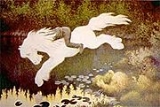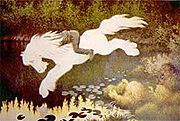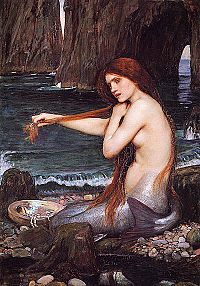
Hebridean mythology and folklore
Encyclopedia
The Inner
and Outer Hebrides
off the western coast of Scotland
are made up of a great number of large and small islands. These isolated and mostly uninhabited islands are the source of a number of Hebridean myths and legends. It is a part of Scotland which has always relied on the surrounding sea to sustain the small communities which have occupied parts of the islands for centuries, therefore, it is natural that these seas are a source for many of these legends.
 Kelpie
Kelpie
s were said to occupy several lochs, including one at Leurbost.
 It has been claimed that there is a mermaid
It has been claimed that there is a mermaid
's grave in Benbecula
, but the exact location is unknown. The mermaid was killed in the early nineteenth century after having been seen for a couple of days, before a teenage boy threw a rock at it, killing the entity. Accounts stated that the upper part of the creature was the size of an infant, while the bottom was like a salmon.
who was said to occupy Loch Suainbhal. Resembling a capsized boat, this creature has been reported swimming around for one and a half centuries. Locals say lambs were once offered annually to the creature. Other such creatures have been reported in several other lochs, including Loch Urubhal.
At Loch Duvat in Eriskay
, while out looking for a horse that escaped his farm in the mist, a farmer saw what he thought was his missing beast in the loch. As he approached, he realised he was looking at a strange creature which gave an unearthly yell, sending the farmer running home.
s have been reported off the shores of Lewis over the years, including a sighting reported in 1882 by a German ship off the Butt of Lewis
. The ship, 15 kilometres off the coast, reported a sea serpent around 40 metres in length, several bumps protruding from the water, along its back. Sea serpents have also been reported at the southern side of the island.
 A family of werewolves
A family of werewolves
were said to occupy an island on Loch Langavat
. Although long deceased, they promised to rise if their graves were disturbed.
have been reported in the area of Sandwick
. The lights that float around the area normally announce approaching death for a local. Some say the light belongs to an Irish merchant who was robbed and murdered on the island.
.. Then in South Uist
, a woman walking with two friends in the pitch dark watched as a self-illuminating dog, the size of a collie but with a small head and no eyes, ran towards her. The creature vanished as it bounded past. On reaching home, she described what had happened to her aunt, the older woman told her it was a Cu Sìth
, a fairy dog. One of the heirloom
s of the chiefs
of Clan Macleod
is the Fairy Flag
. Numerous traditions state that the flag originated as a gift from the fairies.
Inner Hebrides
The Inner Hebrides is an archipelago off the west coast of Scotland, to the south east of the Outer Hebrides. Together these two island chains form the Hebrides, which enjoy a mild oceanic climate. There are 36 inhabited islands and a further 43 uninhabited Inner Hebrides with an area greater than...
and Outer Hebrides
Outer Hebrides
The Outer Hebrides also known as the Western Isles and the Long Island, is an island chain off the west coast of Scotland. The islands are geographically contiguous with Comhairle nan Eilean Siar, one of the 32 unitary council areas of Scotland...
off the western coast of Scotland
Scotland
Scotland is a country that is part of the United Kingdom. Occupying the northern third of the island of Great Britain, it shares a border with England to the south and is bounded by the North Sea to the east, the Atlantic Ocean to the north and west, and the North Channel and Irish Sea to the...
are made up of a great number of large and small islands. These isolated and mostly uninhabited islands are the source of a number of Hebridean myths and legends. It is a part of Scotland which has always relied on the surrounding sea to sustain the small communities which have occupied parts of the islands for centuries, therefore, it is natural that these seas are a source for many of these legends.
Kelpies

Kelpie
The kelpie is a supernatural water horse from Celtic folklore that is believed to haunt the rivers and lochs of Scotland and Ireland; the name may be from Scottish Gaelic cailpeach or colpach "heifer, colt".-Description and behaviour:...
s were said to occupy several lochs, including one at Leurbost.
Blue Men
The Blue Men of the Minch (also known as storm kelpies), who occupy the stretch of water between Lewis and mainland Scotland, looking for sailors to drown and stricken boats to sink.Merpeople

Mermaid
A mermaid is a mythological aquatic creature with a female human head, arms, and torso and the tail of a fish. A male version of a mermaid is known as a "merman" and in general both males and females are known as "merfolk"...
's grave in Benbecula
Benbecula
Benbecula is an island of the Outer Hebrides in the Atlantic Ocean off the west coast of Scotland. In the 2001 census it had a usually resident population of 1,249, with a sizable percentage of Roman Catholics. It forms part of the area administered by Comhairle nan Eilean Siar or the Western...
, but the exact location is unknown. The mermaid was killed in the early nineteenth century after having been seen for a couple of days, before a teenage boy threw a rock at it, killing the entity. Accounts stated that the upper part of the creature was the size of an infant, while the bottom was like a salmon.
Loch Monsters
Searrach Uisge - a monsterLake monster
A lake monster or loch monster is a purported form of fresh-water-dwelling megafauna appearing in mythology, rumor, or local folklore, but whose existence lacks scientific support. A well known example is the Loch Ness Monster. Lake monsters' depictions are often similar to some sea monsters...
who was said to occupy Loch Suainbhal. Resembling a capsized boat, this creature has been reported swimming around for one and a half centuries. Locals say lambs were once offered annually to the creature. Other such creatures have been reported in several other lochs, including Loch Urubhal.
At Loch Duvat in Eriskay
Eriskay
Eriskay , from the Old Norse for "Eric's Isle", is an island and community council area of the Outer Hebrides in northern Scotland. It lies between South Uist and Barra and is connected to South Uist by a causeway which was opened in 2001. In the same year Eriskay became the ferry terminal for...
, while out looking for a horse that escaped his farm in the mist, a farmer saw what he thought was his missing beast in the loch. As he approached, he realised he was looking at a strange creature which gave an unearthly yell, sending the farmer running home.
Sea Monsters
Various sea monsterSea monster
Sea monsters are sea-dwelling mythical or legendary creatures, often believed to be of immense size.Marine monsters can take many forms, including sea dragons, sea serpents, or multi-armed beasts. They can be slimy or scaly and are often pictured threatening ships or spouting jets of water...
s have been reported off the shores of Lewis over the years, including a sighting reported in 1882 by a German ship off the Butt of Lewis
Butt of Lewis
The Butt of Lewis is the most northerly point of the Isle of Lewis in the Outer Hebrides. The headland, which lies in the North Atlantic, is frequently battered by heavy swells and storms.-Lighthouse:...
. The ship, 15 kilometres off the coast, reported a sea serpent around 40 metres in length, several bumps protruding from the water, along its back. Sea serpents have also been reported at the southern side of the island.
Werewolves

Werewolf
A werewolf, also known as a lycanthrope , is a mythological or folkloric human with the ability to shapeshift into a wolf or an anthropomorphic wolf-like creature, either purposely or after being placed under a curse...
were said to occupy an island on Loch Langavat
Loch Langavat
Loch Langavat is the name of four freshwater lochs on the island of Lewis and Harris in the Outer Hebrides of Scotland. The name is a Gaelic rendition of Old Norse lang "long" and vatn, meaning "lake", which translates as "long lake."...
. Although long deceased, they promised to rise if their graves were disturbed.
Will-o'-the-wisp
Wills-o'-the-wispWill-o'-the-wisp
A will-o'-the-wisp or ignis fatuus , also called a "will-o'-wisp", "jack-o'-lantern" , "hinkypunk", "corpse candle", "ghost-light", "spook-light", "fairy light", "friar's lantern", "hobby lantern", "ghost orb", or simply "wisp", is a ghostly light or lights sometimes seen at night or twilight over...
have been reported in the area of Sandwick
Sandwick, Shetland
Sandwick is a township in the Shetland Islands, situated 13 miles south of Lerwick in the South Mainland. It comprises a number of distinct settlements in very close proximity to each other, each remaining distinct through being separated by agricultural land...
. The lights that float around the area normally announce approaching death for a local. Some say the light belongs to an Irish merchant who was robbed and murdered on the island.
Fairies
At Luskentyre in Harris, a hound has been known to leave oversized paw prints on the damp sand which vanish suddenly half way across the beach. It is alleged that this is a fairy houndCu Sith
The Cù Sìth of Scottish mythology is an enormous, otherworldly hound, said to haunt the Scottish Highlands. Roughly the size of a cow or large calf, the Cù Sìth was said to be dark green in color with shaggy fur and a long braided or curled tail...
.. Then in South Uist
South Uist
South Uist is an island of the Outer Hebrides in Scotland. In the 2001 census it had a usually resident population of 1,818. There is a nature reserve and a number of sites of archaeological interest, including the only location in Great Britain where prehistoric mummies have been found. The...
, a woman walking with two friends in the pitch dark watched as a self-illuminating dog, the size of a collie but with a small head and no eyes, ran towards her. The creature vanished as it bounded past. On reaching home, she described what had happened to her aunt, the older woman told her it was a Cu Sìth
Cu Sith
The Cù Sìth of Scottish mythology is an enormous, otherworldly hound, said to haunt the Scottish Highlands. Roughly the size of a cow or large calf, the Cù Sìth was said to be dark green in color with shaggy fur and a long braided or curled tail...
, a fairy dog. One of the heirloom
Heirloom
In popular usage, an heirloom is something, perhaps an antique or some kind of jewelry, that has been passed down for generations through family members....
s of the chiefs
Scottish clan chief
The Scottish Gaelic word clann means children. In early times, and possibly even today, clan members believed themselves to descend from a common ancestor, the founder of the Scottish clan. From its perceived founder a clan takes its name. The clan chief is the representative of this founder, and...
of Clan Macleod
Clan MacLeod
Clan MacLeod is a Highland Scottish clan associated with the Isle of Skye. There are two main branches of the clan: the Macleods of Harris and Dunvegan, whose chief is Macleod of Macleod, are known in Gaelic as Sìol Tormoid ; the Macleods of Lewis, whose chief is Macleod of The Lewes, are known in...
is the Fairy Flag
Fairy Flag
The Fairy Flag is an heirloom of the chiefs of Clan MacLeod. It is held in Dunvegan Castle along with other notable heirlooms, such as the Dunvegan Cup and Sir Rory Mor's Horn. The Fairy Flag is known for the numerous traditions of fairies, and magical properties associated with it...
. Numerous traditions state that the flag originated as a gift from the fairies.
See also
- Scottish mythologyScottish mythologyScottish mythology may refer to any of the mythologies of Scotland.Myths have emerged for various purposes throughout the history of Scotland, sometimes being elaborated upon by successive generations, and at other times being completely rejected and replaced by other explanatory narratives.-...
- Celtic mythologyCeltic mythologyCeltic mythology is the mythology of Celtic polytheism, apparently the religion of the Iron Age Celts. Like other Iron Age Europeans, the early Celts maintained a polytheistic mythology and religious structure...
- History of the Outer HebridesHistory of the Outer HebridesThe Hebrides were settled early on in the settlement of the British Isles, perhaps as early as the Mesolithic era, around 8500-8250 BC, after the climatic conditions improved enough to sustain human settlement. There are examples of structures possibly dating from up to 3000 BC, the finest example...
- HebridesHebridesThe Hebrides comprise a widespread and diverse archipelago off the west coast of Scotland. There are two main groups: the Inner and Outer Hebrides. These islands have a long history of occupation dating back to the Mesolithic and the culture of the residents has been affected by the successive...
- RocabarraighRocabarraighRocabarra or Rocabarraigh is a phantom island or rock in Scottish Gaelic myth, which is supposed to appear three times, the last being at the end of the world.The name confusingly has also been used to refer to Rockall, a real rock in the North Atlantic...

